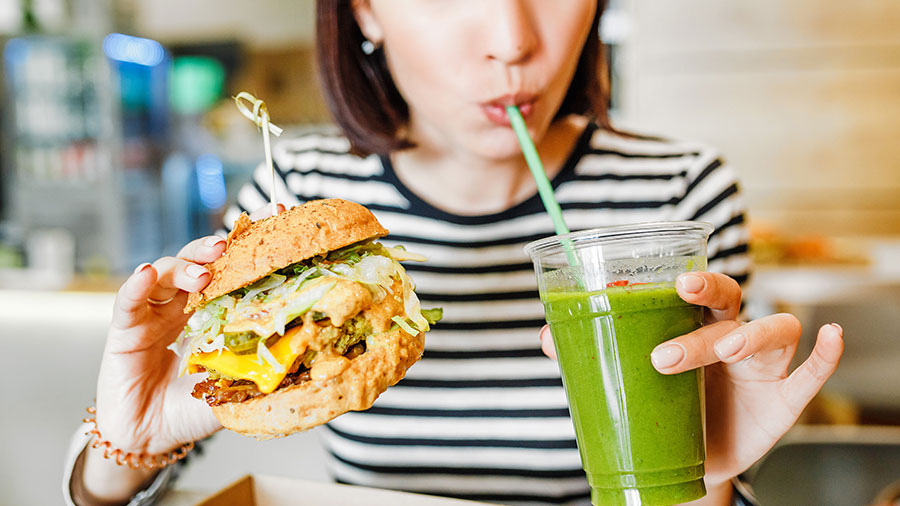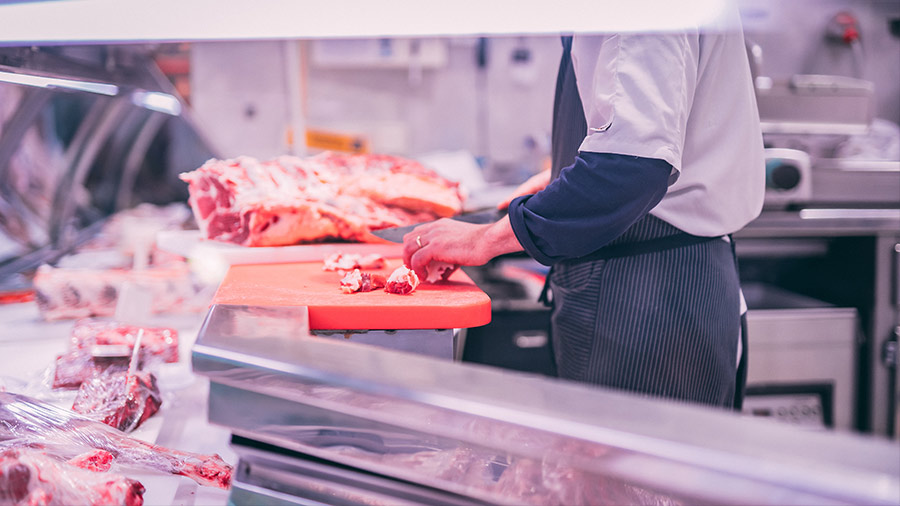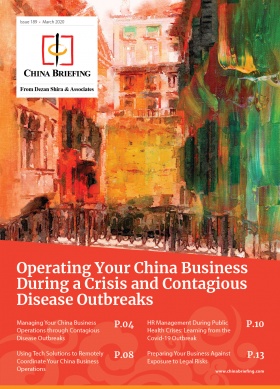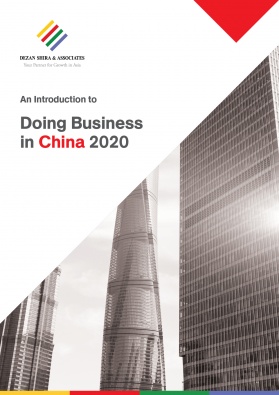China Issues Consumption Coupons to Boost Retail Recovery After Coronavirus Shutdown Ends
- China’s retail sector made a slower than expected recovery in March, reporting a 15.8 percent drop from the previous year. To combat this, China has enabled local governments to issue consumption coupons and encourage shoppers to resume normal spending activities.
- As of April 8, nearly 50 cities across 16 Chinese provinces have issued vouchers that can be redeemed at participating dining, shopping, travel, cultural, and recreational enterprises.
- Vouchers may be a first step to instilling consumer confidence, but market watchers are still on the fence over their impact, and continue to press for more stimulus measures.
While most businesses and factories in China have returned to work, not all parts of the economy have been as quick to get back up and running.
Retailers, restaurants, and recreational centers continue to see significant decreases in activity compared with the previous year, market watchers noting that while there has been an uptick in customers since the lockdown ended, it is still a long road to go to normality.
In January to February this year, China’s retail sales dropped 20.5 percent, and made a slower than expected recovery in March, which reported another significant drop of 15.8 percent from the previous year.
Concerned with both the safety of going outside and the possibility of future layoffs, China’s residents have remained reluctant to spend money as usual.
To combat this, one of the ways in which China is choosing to spur consumer confidence is through the use of local government-issued online consumption vouchers that provide incentives to shoppers.
As of April 8, nearly 50 cities across 16 provinces have issued some form of a voucher system, which can be redeemed at participating dining, shopping, travel, and recreational enterprises.
Better yet, many cities have committed to multiple rounds of voucher releases over the next two to three months.
With the rest of the world at a standstill due to extended quarantines and lockdowns, China’s use of government-issued vouchers may provide early lessons on how to revitalize an economy after COVID-19.
What is China doing to boost consumption?
The task to kickstart the country’s retail consumption has largely fallen on local governments, with the national government appearing reluctant to roll-out any substantive policies.
Some believe that this is a deliberate move to avoid further stretching of the national fiscal reserves, following the monumental but widely criticized stimulus package released in 2009 after the 2008 global financial crisis.
Consequently, a series of targeted, and often creative, policies have been introduced by the local government in each city.
Most of the coupons in each city have been distributed using third-party platforms, such as Alibaba, Tencent, and Meituan Dianping – highlighting a symbiotic public-private partnership in the making to tackle a collective problem that threatens both parties.
We highlight two different policies rolled out by local governments below to illustrate the way the scheme works:
Hangzhou, Zhejiang
As of April 20, Hangzhou’s government had released five rounds of electronic consumer coupons. The latest round saw 1.5 million vouchers released to the public. The vouchers are valid for seven days from April 21 before expiring.
All residents of Hangzhou are eligible for one coupon packet per week, valued at RMB 50 (US$7), distributed through five separate vouchers. Consumers can acquire the coupon by simply searching “Hangzhou Consumer Voucher Activity” on Alipay and can apply for up to five general consumer coupons (“spend 40 RMB, get RMB 10 off”). These vouchers are redeemable at a wide variety of different businesses ranging from breakfast shops, gas stations, to the medical clinics.
So far, Hangzhou has reportedly spent over RMB 320 million in government subsidies, driving consumption by RMB 3.4 billion (RMB 480 million).
Many businesses have simultaneously released their own vouchers to boost sales and customer loyalty, with business discounts in Hangzhou reportedly reaching RMB 1.18 billion (US$170 million) as of March 26.
One example of this is Suning, the electronic retail giant, which also sells clothing and groceries, and handed out RMB 620 million (US$88.7 million) worth of vouchers in late March to around one million people and saw purchases of chicken breast, beef, beverages, and snacks more than double in a week.
Similarly, Alibaba is giving away 10 million discount coupons targeting 10,000 retailers, and JD will give out RMB 1.5 billion (US$210 million) of coupons for goods.
Further, in Zhejiang province, companies have been encouraged to give employees an extra half day of paid leave once a week to encourage them to use their free time to shop and spend.
Similar policies have been issued in Jiangxi and Gansu Province to promote consumption.
Wuhan, Hubei
Wuhan, the city at the epicenter of the coronavirus outbreak started distributing its first round of weekly vouchers from April 19 to May 31, following the end of a two and a half months long shutdown.
The estimated value of the vouchers issued so far totals RMB 500 million (US$70.7 million).
Both locals and non-locals can apply for the vouchers, and consumers will be able to use them in restaurants, shopping malls, supermarkets, convenience stores, and cultural, sport, and tourist sites.
A special consumption voucher program earmarked at RMB 18 million (US$2.55 million) will be allocated for those deemed to be lower income earners. This will be determined by filling out a form upon application for the voucher.
During the first stage of the release, residents in Wuhan were only able to use the vouchers when their actual expenses reached or exceeded three times the voucher value. For example, this meant that a consumer had to spend RMB 150 (US$21) before RMB 50 (US$7) was discounted.
As of April 21, over 26,000 consumer coupons have been used, and a total of 2,506 merchants were able to enjoy preferential treatment under this voucher scheme.
The second phase of the voucher release will begin from June 1 to July 31. Details of this will be announced separately.
The challenge ahead – instilling ongoing confidence among consumers, sustaining businesses
Though there are small signs of increased retail activity for March, the road to normalization in China will be long.
Restarting the economy will be a lot tougher than it was following the global financial crisis in 2008, when China unveiled a RMB 4.14 trillion (US$586 billion) spending package that included funding for big construction projects, and increased demand in steel, glass, and cement factories as a result.
Since then, China’s economy has tripled in size, grown more complex, and shifted towards more service-driven industries. Consequently, any stimulus measures to resuscitate the economy will look different in 2020. The growth of and emphasis on expanding China’s services sector explains why the government is keen to incentivize people to go out and spend money in key sectors as retail, hospitality, transport, and tourism.
Meanwhile, the voucher scheme appears to be producing positive outcomes and have directly promoted domestic retail consumption. For example in Hangzhou, the RMB 320 million (US$45.3 million) reported government spending (as of April 16), had the effect of driving consumption by RMB 3.4 billion (US$480 million).
This impact is also backed by a report released by Zhongtai Securities, an investment banking firm based in Jinan, that suggests that such coupons could result in consumption increasing by more than 8 percent, based on a coupon leverage range of 10-15 times.
Further, consumers are not the only ones who have benefited from the scheme, businesses are also benefiting from a fresh wave of foot-traffic and sales.
A survey conducted by Alipay shows that over 10 million businesses have benefited from the nationwide voucher campaigns, with 90 percent of them being SME enterprises.
Still, many observers cast doubt on the long-term effect of these vouchers, stating that the current coupon amounts are too modest and restrictive to stimulate the much-needed discretionary spending.
Presently, the vouchers, ranging anywhere between RMB 20 (US$3) to RMB 100 (US$14) tend to be spent on necessary items like food, toiletries, and household items, rather than on dining out, travel, or recreational activities.
Specifically, spending on cooking oil, food, and grains rose 19.2 percent in March, while auto sales dropped 18.1 percent and catering plunged 46.8 percent.
Nevertheless, the vouchers offer an important first step to instilling confidence among Chinese consumers, not only to spend, but to also feel safe to leave the house.
However, such measures need to be complemented by further stimulus measures to see any sustained effect. Economists are likely watching what those measures will look like with bated breath.
Wang Jun, a member of the academic committee at the China Center for International Economic Exchanges and chief economist at Zhongyuan Bank, told the Global Times on Sunday, “the impact on the whole country and its GDP is still to come. It’s a combination of fiscal and monetary policy and other stimulus measures that could push the world’s second-largest economy back on a fast track.
Explore Our Coverage of New Business Opportunities in China
 Starbucks, KFC Offer Plant-Based Meat Options in China, Tap into New Consumption Trends
Starbucks, KFC Offer Plant-Based Meat Options in China, Tap into New Consumption Trends
 How COVID-19 Will Transform the Fresh Food Industry in China
How COVID-19 Will Transform the Fresh Food Industry in China
 New Business Opportunities Emerging in China Under COVID-19 Outbreak
New Business Opportunities Emerging in China Under COVID-19 Outbreak
About Us
China Briefing is written and produced by Dezan Shira & Associates. The practice assists foreign investors into China and has done since 1992 through offices in Beijing, Tianjin, Dalian, Qingdao, Shanghai, Hangzhou, Ningbo, Suzhou, Guangzhou, Dongguan, Zhongshan, Shenzhen, and Hong Kong. Please contact the firm for assistance in China at china@dezshira.com.
We also maintain offices assisting foreign investors in Vietnam, Indonesia, Singapore, The Philippines, Malaysia, and Thailand in addition to our practices in India and Russia and our trade research facilities along the Belt & Road Initiative.
- Previous Article How to Tap into China’s Plant-Based Meat Market: Key Considerations
- Next Article How to Legally Reduce Labor Costs in China During the Coronavirus Outbreak








